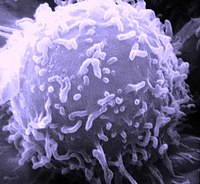
Photo from wikipedia
Upon pathogen recognition, some plant immune receptors assemble into active enzyme complexes Higher plants have evolved complex immune systems. Intracellular immune receptors known as nucleotide-binding leucine-rich repeat (NLR) proteins are… Click to show full abstract
Upon pathogen recognition, some plant immune receptors assemble into active enzyme complexes Higher plants have evolved complex immune systems. Intracellular immune receptors known as nucleotide-binding leucine-rich repeat (NLR) proteins are present in both plants and animals; they are essential for immune responses (1). Upon infection, NLRs can recognize specific pathogen molecules and activate defense. In contrast to animals, which have a limited NLR repertoire, higher plants usually harbor hundreds of diverse NLR genes. However, little is known about their activation and signaling mechanisms. On pages 1184 and 1185 of this issue, Ma et al. (2) and Martin et al. (3), respectively, reveal the structure and activation mechanism of two NLRs: Arabidopsis thaliana RECOGNITION OF PERONOSPORA PARASITICA 1 (RPP1) and Nicotiana benthamiana RECOGNITION OF XOPQ 1 (ROQ1). Both NLRs self-assemble in a similar manner into tetrameric holoenzymes to activate defense responses upon direct effector recognition.
Journal Title: Science
Year Published: 2020
Link to full text (if available)
Share on Social Media: Sign Up to like & get
recommendations!